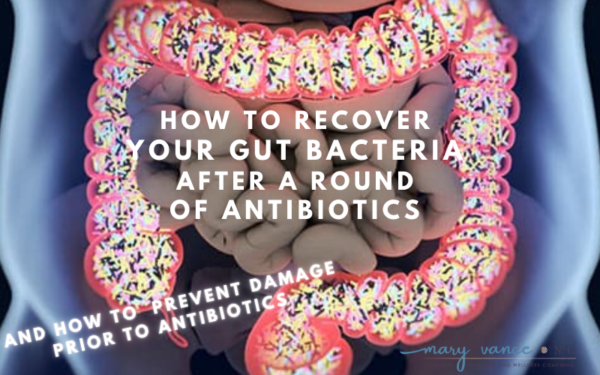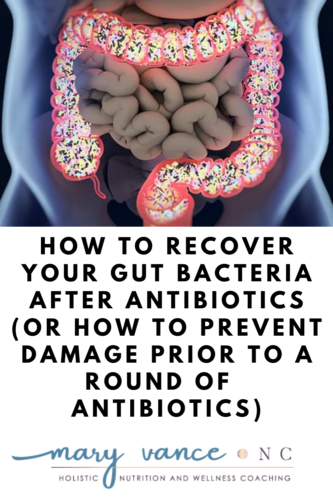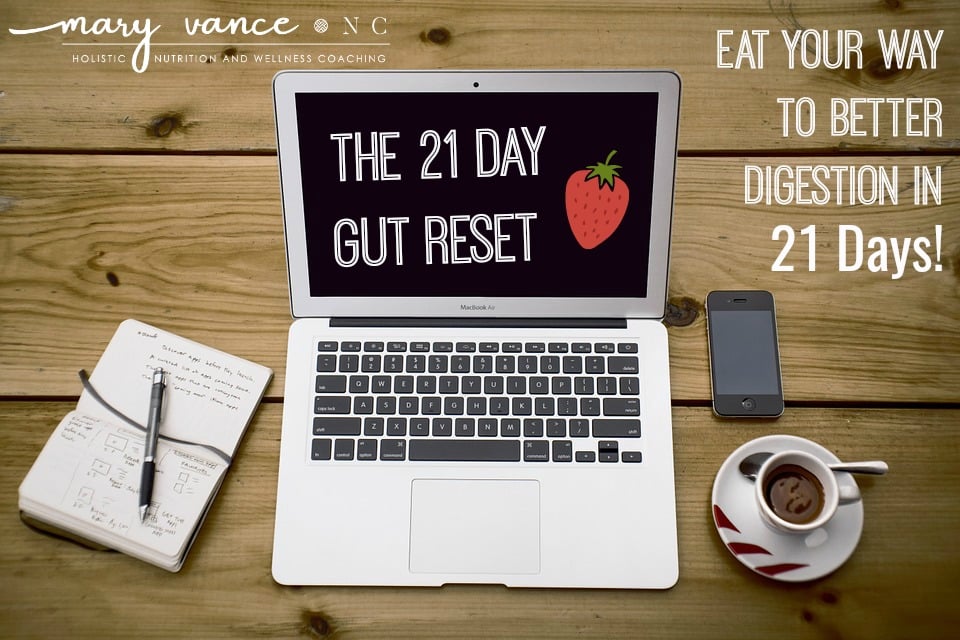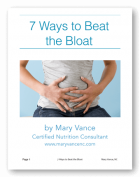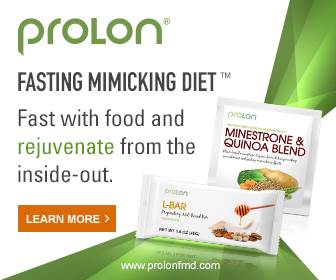Antibiotics are unquestionably one of the most important medical advances known to man. Suddenly we had the ability to cure common yet potentially life-threatening infections and prevent the spread of communicable bacterial illness. But even one course of antibiotics can completely decimate your beneficial gut bacteria, the microbes that keep you healthy and able to digest food effectively. But you can recover your gut bacteria after a round of antibiotics, or even prevent damage in the first place.
Your gut (large intestine mainly) may contain up to 500 different species of microbes: mostly bacteria, but also viruses, archaea, fungi. A rich and diverse gut microbiota promotes health via chronic disease prevention, a robust immune system, and promoting digestion and absorption of nutrients. In contrast, poor microbial diversity in the gut is a common thread in chronic diseases including obesity, diabetes, asthma and gut inflammatory disorders. (source)
An international team of researchers reported that when three antibiotics were given to young, healthy men for four days it caused an almost complete eradication of gut bacteria, followed by a gradual recovery of most bacterial species over a period of six months. After the six months, however, the study participants were still missing nine of their common beneficial bacteria, and a few new potentially non-desirable bacteria had colonized the gut. (source) The broad spectrum antibiotic in the study was designed to mimic actual treatments in intensive care units.
How Do Antibiotics Work
Antibiotics are medications (like penicillin, probably the most well known) that fight infections caused by bacteria (not viruses like the common cold or flu). They kill or decrease bacteria or prevent infections from worsening or becoming deadly. Antibiotics are commonly prescribed for urinary tract infections, ear infections, pneumonia, sinus infections, strep, post surgery, or wounds.
Antibiotics were long considered fairly harmless yet effective drugs, which is why doctors prescribed them so regularly, either as a precaution or for something basic like a sore throat. Overuse or careless use of antibiotics early in life seems to be particularly problematic for future gut health and proper immune system function. Even some women who take certain antibiotics while pregnant may negatively affect the microbiome of their future children. (source)
Antibiotics kill bacteria that cause or worsen infections, but unfortunately, they cannot distinguish between beneficial bacteria and the bacteria causing the illness. So when you take a round of antibiotics, they destroy the good microbes that live in your large intestine and keep you healthy. This can open the door for harmful pathogens such as E.coli, C.diff and Salmonella infections that may be severe.
Common side effects from taking antibiotics include yeast infections which can become chronic candida, diarrhea, or digestive upset as beneficial bacteria dwindle. Long term, these side effects can prevent you from absorbing nutrients from food and even cause changes to mental health because of the gut-brain connection (read more on that here).
I often see C. difficile (Clostridioides difficile) bacterial infection result from antibiotic use. You can test for this via the GI MAP stool test. C. diff causes diarrhea and can be quite serious in some people. C. diff is an opportunistic pathogen, meaning that when antibiotics wipe out the gut’s good bacteria, bad guys like C. diff take the opportunity to flourish and make an unpleasant party in your gut.
How to Recover Your Gut Bacteria after Antibiotics
It takes the gut time to recover back to healthy, diverse bacteria levels, and research shows the microbiome can recover in healthy people. In general though, there is evidence that Western populations have a considerably lower diversity of their gut microbiota than native people living in certain parts of Africa and Amazon, for example. One possible explanation for this may be the widespread use of antibiotics here in the U.S. and potentially overuse, which has led to a host of problems like antibiotic resistant strains of bacteria. The Western processed Standard American diet along with antibiotic overuse could be one explanation for the many digestive problems and obesity and diabetes rates in this country.
Truly, health starts with your gut. If you have taken antibiotics recently and are noticing a change in digestion, there are steps you can take to recover gut health. The main objectives are to replace strains of probiotic bacteria that were killed and to heal to gut. Probiotics are your good gut bacteria that support healthy digestion, produce nutrients, get rid of toxins and pathogens, and help you support normal weight, appetite, and body composition.
PRE-GAME: I always recommend the GI MAP stool test (which you can find and order yourself via this test menu) to anyone experiencing digestive issues like constipation, diarrhea, heartburn, bloating, or chronic indigestion. This test also screens for C. diff or other potential infections that can be caused by antibiotic use, then you’ll better know how to tailor your treatment (e.g. killing off unwanted pathogens with specific anti-microbial herbs). The GI MAP also measures levels of beneficial bacteria, so you’ll know the particular strains in which you are deficient. That helps you design your probiotic treatment.
THE FIRST STEP to recover your gut bacteria after antibiotics is to take a multi-strain probiotic supplement with more than 50 billion CFUs (colony forming units). You want lactobacillus species, bifidobacteria, and saccharomyces boulardii (sacc b). Sacc b is really the superstar in recovering after antibiotics or for preventing damage while taking antibiotics. Several studies show that sacc b prevents antibiotic-associated diarrhea. (source).
After your antibiotic treatment, I recommend this probiotic from Elixia to help recolonize with beneficial species. It contains 500 billion CFUs and is designed to help your gut recover from antibiotic damage. It also contains 11 beneficial probiotic strains. It’s a short course (you don’t actually want to take that dosage long term). After you finish that, take the Body Ecology GI Distress relief probiotic that contains sacch b and beneficial bifido species that fight yeast (a real problem caused by antibiotics) and help recolonize your GI tract.
Once you finish a bottle of the GI Distress Relief, you can transition to a general probiotic like this one from Designs for Health for a month or two to complete the treatment.
SIDE NOTE: I personally vet all supplements I recommend and have tried all these products. If you can only afford one, I recommend the GI Distress probiotic, as it contains sacc b and important bifido strains that are easily killed by antibiotics. I have seen great results from this one!
DIET & GUT REPAIR: Aside from the probiotic supplements, you’ll need to employ some gut healing strategies to reduce inflammation and repair the gut lining. Your probiotic bacteria live in the mucosal lining that coats and protects your gut, so it’s important to focus on foods that support Akkermansia, the mucin-producing bacteria (read: they help produce that mucosal lining). Akkermansia bacteria love polyphenols, so get plenty of berries, olives & olive oil, pomegranate (truly a gut superfood!), and leafy greens. Use this GI Revive daily to help heal leaky gut and repair the mucosal lining.
Overall you’ll need a diet rich in prebiotic fibers (from fruits & veggies) that feed your probiotic bacteria. Read more about a microbiome-boosting diet here so you’ll know specifically which foods to include. Resistant starch, which you can add to smoothies, is a wonderful prebiotic. Try this one. A diet rich in fermented foods like raw kraut, kefir, and kimchi also nourishes the gut. Check out my top gut healing foods list here. And make sure to read this post on how to boost your gut flora.
Additionally, ditch the white sugar and booze. Both damage your gut and kill probiotic bacteria.
To recover your gut flora after antibiotics you will need:
- A round of Elixia to take after the antibiotics
- A bottle of GI Distress Relief for sacc b & beneficial bifido strains
- GI Revive
- Bonus: Resistant starch to feed your probiotic bacteria and encourage them to colonize
- A microbiome boosting diet
How to Prevent Damage if You Must Take Antibiotics
Sometimes antibiotics are unavoidable, especially for surgeries or wounds. If you do have to take antibiotics for any reason, you can do so without wiping out your gut flora and experiencing harmful side effects.
You can take a probiotic while you’re taking the antibiotics. This will help mitigate the damage from the antibiotic. Take the GI Distress Relief that contains sacc b while you’re on the antibiotics. It’s important to take the probiotics two hours away from the antibiotic, or it’ll kill the probiotics (except sacc b which is antibiotic resistant. But still, take both away from the antibiotic).
Once you are finished with the antibiotic, take one round of the Elixia, the 500 billion CFU formula that is designed to help your gut heal after antibiotics. You can also do the GI Revive for extra support. You may then need an additional probiotic for a month or so. Try this one, or check out my guide on how to determine which probiotic is right for you.
Follow the microbiome boosting diet explained in the section above (here’s that post).
It is possible to both heal the gut and prevent damage from antibiotics should you have to take them. It takes time and some care. Most importantly, preserve your good gut health by preventing damage prior to antibiotics in the first place.
Pin it!

Mary Vance is a Certified Nutrition Consultant and author specializing in digestive health. She combines a science-based approach with natural therapies to rebalance the body. In addition to her 1:1 coaching, she offers courses to help you heal your gut and improve your health. Mary lives in San Francisco and Lake Tahoe in Northern California. Read more about her coaching practice here and her background here.

